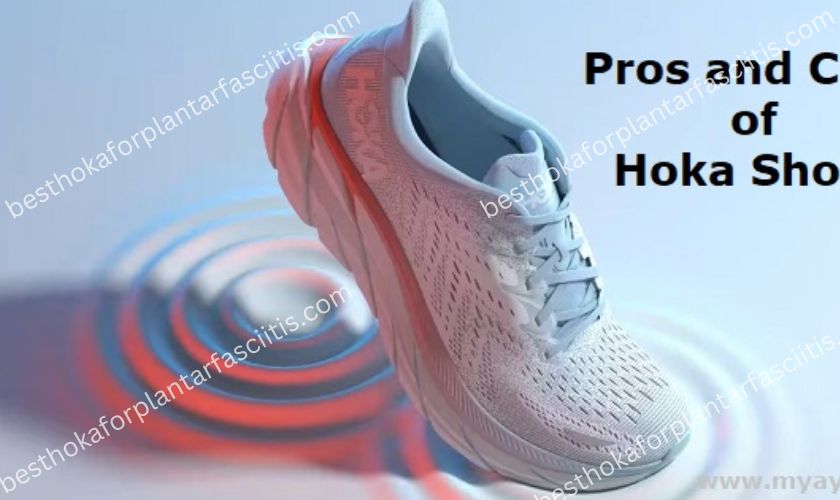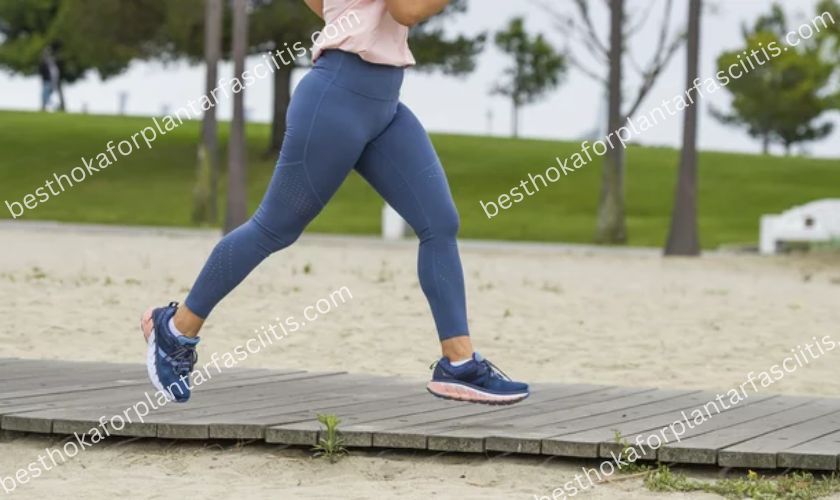Hoka Plantar fasciitis is a common foot condition characterized by inflammation and pain in the plantar fascia, a thick band of tissue that connects the heel bone to the toes. It is often caused by repetitive strain and excessive pressure on the plantar fascia, leading to micro-tears and inflammation.
Finding suitable footwear is crucial for alleviating the symptoms of plantar fasciitis and promoting proper foot mechanics. Hoka shoes have gained popularity as a potential solution for plantar fasciitis relief due to their unique features and design.

Understanding Plantar Fasciitis
Plantar fasciitis is primarily caused by activities that involve repetitive impact on the feet, such as running, jumping, or prolonged standing. Individuals with flat feet or high arches, improper foot mechanics, obesity, or tight calf muscles are more prone to developing plantar fasciitis.
The condition typically presents with symptoms like sharp heel pain, especially in the morning or after periods of inactivity.
Wearing improper footwear exacerbates the symptoms of plantar fasciitis. Shoes that lack proper cushioning, arch support, and stability can increase strain on the plantar fascia, leading to more pain and discomfort. Thus, investing in supportive footwear is crucial for effective relief.
Hoka Shoes An Overview
Hoka is a footwear brand known for its innovative design and focus on providing maximum cushioning. The brand originated in 2009 and quickly gained recognition among runners and athletes for its unique approach to shoe design.
Hoka shoes stand out due to their oversized midsole cushioning, which provides excellent shock absorption and impact reduction.
Hoka shoes offer several key features that make them a potential choice for individuals with plantar fasciitis

Cushioning and Shock Absorption
One of the main advantages of Hoka shoes is their superior cushioning and shock absorption capabilities. The oversized midsole design, often referred to as “marshmallow” or “cloud-like,” significantly reduces the impact on the foot during walking, running, or other activities.
This cushioning helps minimize the strain on the plantar fascia, providing relief and allowing for a more comfortable experience.
Arch Support and Stability
Proper arch support is crucial for individuals with plantar fasciitis as it helps distribute the weight evenly and reduces stress on the plantar fascia. Hoka shoes are designed to provide excellent arch support, helping maintain proper foot alignment and preventing overpronation or excessive rolling of the foot inward.
The stability features in Hoka shoes also contribute to better foot mechanics, reducing the risk of additional strain on the plantar fascia.
Lightweight Design and Flexibility
Despite their significant cushioning, Hoka shoes are surprisingly lightweight. The brand utilizes innovative materials and construction techniques to ensure that the shoes remain lightweight without compromising on support and stability.
The lightweight design reduces the overall strain on the foot, making it easier for individuals with plantar fasciitis to move comfortably. Additionally, Hoka shoes offer a good level of flexibility, allowing for natural foot movement during various activities.
How Hoka Shoes Aid Plantar Fasciitis Relief
The unique design features of Hoka shoes contribute to effective relief for individuals suffering from plantar fasciitis

Proper Alignment and Reduced Strain on the Foot
The cushioning and arch support in Hoka shoes promote proper foot alignment, reducing strain on the plantar fascia.
By providing a stable base and supporting the natural arch of the foot, Hoka shoes help distribute the weight evenly and minimize the pressure on the inflamed tissues. This alignment encourages better foot mechanics and can alleviate pain
Cushioning and Shock Absorption for Impact Reduction
The generous cushioning in Hoka shoes plays a crucial role in reducing the impact on the foot. When walking or running, each step creates a significant amount of force that can aggravate plantar fasciitis pain.
The plush cushioning in Hoka shoes absorbs much of this impact, protecting the plantar fascia from excessive stress. This feature allows individuals with plantar fasciitis to engage in their daily activities with reduced pain and discomfort.
Enhanced Arch Support and Stability for Better Foot Mechanics
Hoka shoes are engineered to provide excellent arch support, which is vital for individuals with plantar fasciitis. The arch support helps maintain the natural curvature of the foot, preventing it from collapsing or overpronating.
By supporting the arch, Hoka shoes distribute the weight evenly and reduce strain on the plantar fascia. This added stability contributes to better foot mechanics, minimizing the risk of further damage or inflammation.
Choosing the Right Hoka Shoes for Plantar Fasciitis
While Hoka shoes offer several benefits for plantar fasciitis relief, it’s essential to choose the right pair that caters to individual needs. Consider the following factors when selecting Hoka shoes.

Understanding Different Hoka Shoe Models
Hoka offers a range of shoe models, each designed for specific activities and foot types. Understanding the differences between models can help individuals select the most suitable option.
Some models, such as the Hoka Bondi or Hoka Clifton, are known for their maximum cushioning, making them ideal for individuals with severe plantar fasciitis or those who prioritize comfort. Other models, like the Hoka Arahi or Hoka Gaviota, focus on stability and support, which can be beneficial for individuals with overpronation.
Factors to Consider When Selecting Hoka Shoes for Plantar Fasciitis
1. Foot Type and Pronation Individuals with high arches may benefit from shoes with more pronounced arch support, while those with flat feet may require shoes with a flatter arch. Additionally, understanding one’s pronation (neutral, overpronation, or underpronation) can help choose the appropriate level of stability and support.
2. Shoe Sizing and Fit Proper fit is crucial for optimal support and comfort. It’s recommended to try on Hoka shoes and ensure there is adequate room in the toe box while maintaining a secure fit around the heel and midfoot. Consider consulting a shoe fitting expert for guidance.
3. Activity Level and Intended Use Different Hoka models are designed for various activities, such as running, walking, or hiking. Consider the intended use and select a model that aligns with the desired activity level and terrain.
Other Tips and Strategies for Plantar Fasciitis Relief
While Hoka shoes can provide significant relief for plantar fasciitis, they are not the sole solution. It’s essential to incorporate other strategies and practices to enhance the management of plantar fasciitis
Stretching and Strengthening Exercises
Performing specific exercises to stretch and strengthen the muscles and ligaments in the feet and lower legs can alleviate plantar fasciitis symptoms. Examples include calf stretches, toe stretches, and towel curls. Consult a healthcare professional or physical therapist to learn appropriate exercises for your condition.
Footwear Considerations Beyond Hoka Shoes
While Hoka shoes are known for their benefits, it’s important to consider footwear choices in different scenarios. For example, individuals with plantar fasciitis may require supportive shoes even when not engaging in intense physical activities, such as wearing supportive slippers or shoes with orthotic inserts at home.
Seeking Professional Guidance and Medical Treatment
If plantar fasciitis symptoms persist or worsen, it is advisable to seek professional guidance and medical treatment.
A healthcare professional specializing in foot conditions, such as a podiatrist, can provide a comprehensive assessment of your condition and recommend appropriate treatment options.
They may suggest custom orthotics, which are specialized shoe inserts designed to provide personalized support and alignment for your feet. These orthotics can be used in conjunction with Hoka shoes to enhance the benefits and address specific foot issues.
In some cases, additional therapies may be recommended, such as physical therapy or extracorporeal shockwave therapy (ESWT), which uses high-energy sound waves to stimulate healing in the affected area.
The healthcare professional can guide you through these treatment options based on the severity and duration of your plantar fasciitis.

Conclusion
Hoka shoes offer several benefits for individuals seeking relief from plantar fasciitis. Their cushioning, arch support, stability, and lightweight design make them a popular choice among those suffering from this condition.
By providing proper alignment, shock absorption, and reducing strain on the plantar fascia, Hoka shoes can significantly alleviate pain and discomfort.
When selecting Hoka shoes, it is essential to consider factors such as foot type, pronation, sizing, and intended use. Consulting with a shoe fitting expert or healthcare professional can help ensure the right choice for your specific needs.
While Hoka shoes are an effective tool for plantar fasciitis relief, they should be complemented with other strategies like stretching exercises, strengthening routines, and, if necessary, professional medical treatment.
By adopting a comprehensive approach, individuals with plantar fasciitis can effectively manage their symptoms and improve their foot health and overall quality of life.
Remember, each individual’s experience with plantar fasciitis may vary, and it’s important to listen to your body and seek appropriate medical advice for your specific situation.
With the right combination of supportive footwear, exercises, and professional guidance, plantar fasciitis can be effectively managed, allowing you to stay active and pain-free.